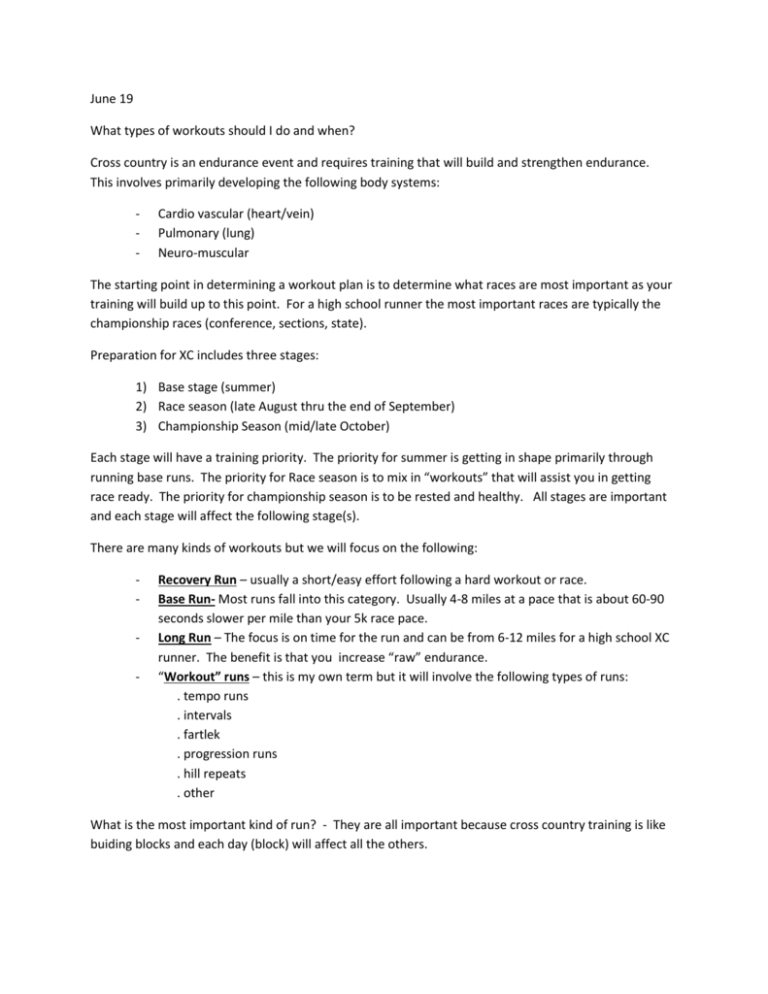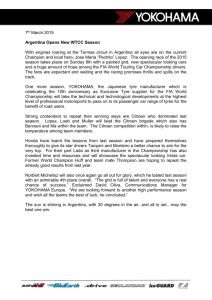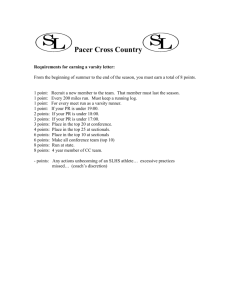June 19 What types of workouts should I do and when? Cross
advertisement

June 19 What types of workouts should I do and when? Cross country is an endurance event and requires training that will build and strengthen endurance. This involves primarily developing the following body systems: - Cardio vascular (heart/vein) Pulmonary (lung) Neuro-muscular The starting point in determining a workout plan is to determine what races are most important as your training will build up to this point. For a high school runner the most important races are typically the championship races (conference, sections, state). Preparation for XC includes three stages: 1) Base stage (summer) 2) Race season (late August thru the end of September) 3) Championship Season (mid/late October) Each stage will have a training priority. The priority for summer is getting in shape primarily through running base runs. The priority for Race season is to mix in “workouts” that will assist you in getting race ready. The priority for championship season is to be rested and healthy. All stages are important and each stage will affect the following stage(s). There are many kinds of workouts but we will focus on the following: - Recovery Run – usually a short/easy effort following a hard workout or race. Base Run- Most runs fall into this category. Usually 4-8 miles at a pace that is about 60-90 seconds slower per mile than your 5k race pace. Long Run – The focus is on time for the run and can be from 6-12 miles for a high school XC runner. The benefit is that you increase “raw” endurance. “Workout” runs – this is my own term but it will involve the following types of runs: . tempo runs . intervals . fartlek . progression runs . hill repeats . other What is the most important kind of run? - They are all important because cross country training is like buiding blocks and each day (block) will affect all the others. We already mentioned the three stages of a successful cross country season (summer, race, championship). The idea in cross country training is that you put the proper mix of runs into the proper stage of the season. Summer – per week – 3-4 base runs, 1 long run, 1 workout (see below) Race Season – per week – 3-4 base runs, 1 long run, 2 workouts (one might be an actual race) Championship season – 3-4 base runs, 1-2 lighter workout runs, 1 race SUMMER The focus on here is to build base. At the beginning of the summer the training will consist of mostly base runs to “get you in shape”. By the end of June or early July it is good to add one long run to your weekly training and also one “Workout run” to your training. Here is a general recommendation for summer training. Beginner/new runner: shoot for running 5 days/week and total 15-20 miles total for your weekly runs. Most runs will be base runs of 3-5 miles. When you add a “long” run later in July it could be 6-7 miles or about 20% longer than a normal base run. When you add a “workout” run in July you can do a fartlek ( 6 x 1 minute hard with 1 minute easy) in the middle of one of your runs after a good warm up. In later July you can change your weekly “workout run” to 6 x 2 minutes hard with 2 minutes easy jog between. Returning runner: shoot for running 5 days a week and a total of 25-35 miles for your weekly total. Most runs should be base runs of 4-6 miles. Your long run will be 7-9 miles and your workout run can be a fartlek of 6 x 2 minutes hard with 2 minutes easy jogging done in the middle of one of your runs. In the later part of the summer you can switch your workout run to 5 x 3 minutes hard with 2 minutes easy jog. Elite runner: shoot for running 6-7 days/week ( it is recommended at least one day off every 2 weeks). Your weekly mileage total should be 40-55 miles. Most runs should be base runs of 6-8 miles. Long run can be 9-10 miles. “Workout run” can be tempo run of 15 minutes (5k race pace plus 30 seconds per mile pace) one week and fartlek run (8 x 2 min hard and 2 minute jog) the next week. RACE SEASON This stage starts with the first official practice in mid/late August. The majority of these runs will still be base runs and the coach will likely add some additional “workout runs”. Where in the summer you will be doing one “workout run” each week. During this part of the season you might be doing two per week. This part of the season will include the introduction of intervals. You will be mixing in these workouts into your racing schedule. Don’t forget that early races also serve a great purpose for training and improvement. It is important not to lose focus during this part of the season. The primary purpose of this stage is to help you learn to race, learn to compete, and improve. Mistakes are OK as this part of the season sets the stage for the championship season which will follow. You can build experience, confidence, and fitness during this stage of the season. Championship Season This part of the season is usually the last couple of weeks (2-3 weeks) and involves reducing your total running mileage. You are focusing on getting more rest and staying sharp. Daily runs are usually shorter than during the regular season. By this time of the season the “hay is in the barn” meaning you have already done the heavy lifting and hard work during the summer and regular season. What allows the most success in the championship season is rest, a great attitude, and staying mentally sharp during practice. IMPORTANT IDEAS 1. Training for cross country takes time and should be a steady build up over time. Each past season is an important layer for the next. 2. General guidelines for weekly mileage: a. 7-8 grade boys – 20-30 miles per week b. 9-10 grade boys – 30-40 miles per week c. 11-12 grade boys- 40-50 miles per week d. 7-8 grade girls – 15-25 miles per week e. 9-10 grade girls – 25-30 miles per week f. 11-12 grade girls – 30-35 miles per week 3. There is a difference between being sore and being injured and it is not always easy to tell the difference. If you feel a pain that lasts more than one day you should talk to your coach to determine if it is important to take more time off to heal an injury. 4. How fast should I go? - Base runs are about 60-90 seconds slower per mile than your 5k race pace (boys), 4k race pace for girls. - Long run – about 2 minutes per mile slower than your 4k/5k race pace - Tempo Run – about 30 seconds per mile slower than your 4k/5k race pace 5. The best way to improve as a distance runner is to be able to gently increase your weekly training mileage over time. Usually recommended no more than 5% per week during any build up. 6. Overtraining – This usually results when people do too much too soon. They can get injured and or just flat and tired all the time. If you stick the recommended mileage from above you should have the right mix of running volume, running intensity, and rest. 7. A good runner is a smart runner who focuses on the training goal for the day. If it is a recovery run then it should be easy. Know your pace for each kind of run.






